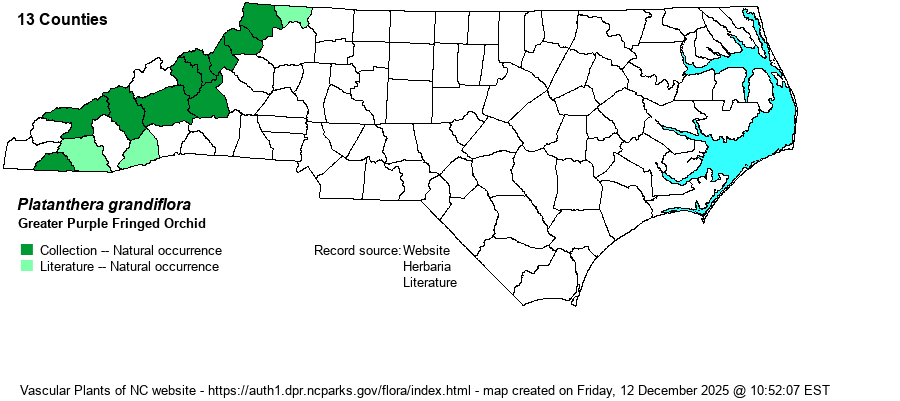| Section 5 » Order Orchidales » Family Orchidaceae |
Show/Hide Synonym
| taxonName | relationship | relatedTaxonName | relatedTaxonRefText | relComments |
|---|
|
|
|
| Platanthera grandiflora | < | Platanthera grandiflora | Flora of North America (1993b, 1997, 2000, 2002a, 2002b, 2003a, 2004b, 2005, 2006a, 2006b, 2006c, 2007a, 2009, 2010) | | | Platanthera grandiflora | < | Platanthera grandiflora | | | | Platanthera grandiflora | < | Platanthera grandiflora | | | | Platanthera grandiflora | < | Platanthera grandiflora | | | | Platanthera grandiflora | < | Platanthera grandiflora | Wofford (1989) | | | Platanthera grandiflora | < | Habenaria psycodes var. grandiflora | Gleason and Cronquist (1991) | | | Platanthera grandiflora | < | Habenaria psycodes var. grandiflora | Gleason (1952) | | | Platanthera grandiflora | < | Habenaria psycodes var. grandiflora | Radford, Ahles, and Bell (1968) | | | Platanthera grandiflora | < | Habenaria psycodes var. grandiflora | Brown (2002)=Z. | | | Platanthera grandiflora | < | Habenaria fimbriata | Fernald (1950) | | | Platanthera grandiflora | < | Habenaria fimbriata | Flora of West Virginia | | | Platanthera grandiflora | < | Blephariglottis grandiflora | Small (1933, 1938) | | | Platanthera grandiflora | = | Platanthera fimbriata | | | | Source: Weakley's Flora |
|
| Author | (Bigelow) Lindley | |
| Distribution | This species is restricted to higher elevations -- mostly over 4,000 feet elevation -- across the Mountains, though it possibly could be absent at the extreme southwestern tip of the state.
This Northern species ranges across eastern Canada south to PA, and then in the Appalachians south to northern GA. | |
| Abundance | Generally rare to locally uncommon, at high elevations. This is a Significantly Rare species; it formerly was State listed as Threatened (prior to May 2021). | |
| Habitat | Though it grows in cool, high elevations, it generally occurs in damp soils of seepages, bogs, and of other moist sites. Many of these sites are in sunny or semi-open habitats, and it is not generally a species of heavily shaded seepages in cove forests or Northern Hardwood Forests. | |
| Phenology | Blooms in June and early July, and fruits shortly after flowering. Weakley (2018) indicates that it flowers 3-4 weeks earlier than the two other "Purple Fringed Orchids" -- Platanthera psycodes and P. shriveri. | |
| Identification | This is one of the more spectacular of the montane wildflower species in the state. It grows to about 2-2.5 feet tall and has a large flower cluster than can be at least 6 inches tall and 3 inches wide. The several dozen flowers are a light or soft lavender-purple in color, and each flower averages about 1 inch wide and high. The three-part lip is very strongly fringed, mostly so to the base of each part of the lip. The opening to the "nectary" in the center of the flower is clearly rounded, and the flower spur averages over 1 inch long. The closely related P. psycodes, with which it has often been merged as the same species (but as varieties), has smaller flowers, a denser flower cluster, flower spurs mostly just 0.5-0.7-inch long, and the "nectary" opening in the center of the flower is shaped like a dumbbell, with two obvious openings. The flower cluster of P. psycodes is mostly about 3 inches tall. The very recently described P. shriveri has deeply cut lip segments and the base of the lip segments are very narrow; thus, the flowers look very dissected into "frills". | |
| Taxonomic Comments | Most recent references consider this as a valid species now, but for much or most of the last century it was usually considered as a variety -- P. psycodes var. grandiflora. Decades ago, when nearly all Platanthera were named as Habenaria species, it was named as Habenaria psycodes var. grandiflora (as in RAB 1968).
| |
| Other Common Name(s) | Large Purple Fringed Orchid, Greater Purple Fringed Bog Orchid | |
| State Rank | S2 | |
| Global Rank | G5 | |
| State Status | SR-P | |
| US Status | | |
| USACE-agcp | FACW link |
| USACE-emp | FACW link |

